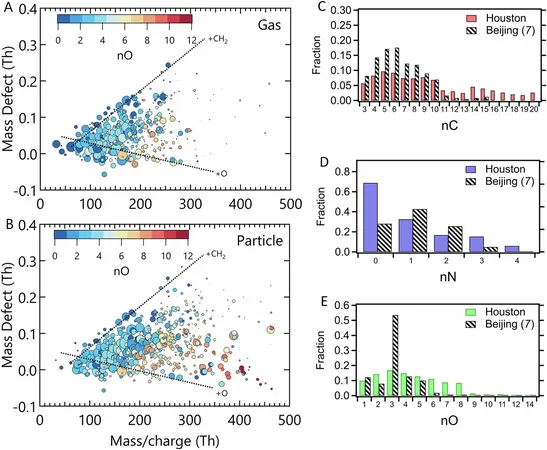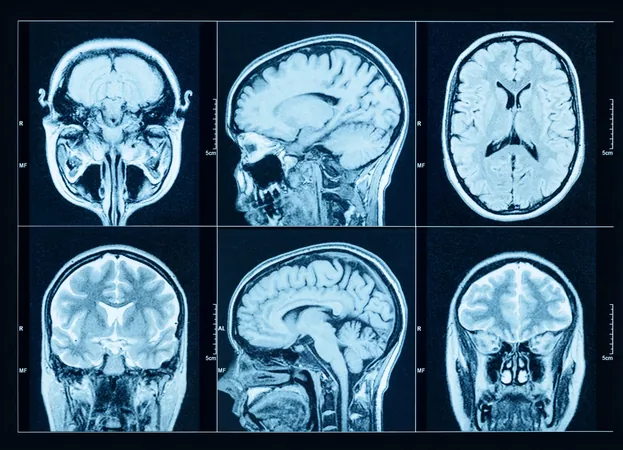
Why Using Data from Chinese Megacities to Measure U.S. Air Quality Could Be Misleading
2025-08-13
Author: Arjun
Groundbreaking Research Uncovers Air Quality Misconceptions
A fascinating new study by researchers at The University of Alabama in Huntsville (UAH) has revealed a critical flaw in how we interpret air quality data. Their findings, published in Communications Earth & Environment, demonstrate that applying atmospheric particle data from bustling Chinese megacities to U.S. urban centers can lead to major inaccuracies.
Field Research Yields Surprising Insights
Dr. Lee Tiszenkel, a UAH alumnus at the Earth System Science Center alongside Dr. Shanhu Lee, a professor in Atmospheric and Earth Sciences, delved deep into this issue through rigorous field research in Houston, Texas. Their exploration highlighted the vast differences in urban air pollution sources between the U.S. and China.
Tiszenkel notes, "Much of our understanding of particle formation has stemmed from studies in Chinese megacities. As a result, existing predictions for U.S. urban air quality lack accuracy." While Chinese research attributes ultrafine particles primarily to human activities—like traffic and industrial processes—Houston's air quality is significantly affected by its green spaces, which introduce additional pollutants.
The Seasonal Dance of Urban Air Pollutants
Unexpectedly, the study also found that air pollution formation in Houston varies with the seasons. This new evidence emphasizes that the complexities of urban pollution can’t be universally applied; they depend significantly on local conditions and emissions.
The Tiny Particles with Big Health Risks
The research focuses on ultrafine particles, less than 100 nanometers in size, which pose serious health risks as they can penetrate deep in our lungs. According to Tiszenkel, understanding how these particles form is vital because they can be triggered by a mix of both human activity and natural environments.
Cutting-Edge Technology Leading to New Discoveries
This groundbreaking study was made possible by a sophisticated new instrument at UAH, known as the Filter Inlet for Gases and Aerosols High-Resolution Time-of-Flight Chemical Ionization Mass Spectrometer. This advanced technology allows for unprecedented particle detection, linking theoretical understanding with real-world observations.
Distinct Urban Environments, Distinct Air Quality Challenges
Tiszenkel emphasizes the stark contrast between megacities like those in China, which are dense and heavily industrialized, and Houston, where surrounding agriculture adds a unique layer of complexity. Influences from biogenic emissions—natural compounds released from plants—play a pivotal role, affecting air quality and health outcomes in ways that differ vastly from more industrialized cities.
A Journey from Lab to Life
Tiszenkel reflects on his evolution from lab-based research to field studies, underscoring the importance of connecting experimental findings with real atmospheric conditions. This approach enhances our understanding of urban air pollution, vital for implementing effective solutions to improve air quality and ultimately, public health.
The Road Ahead for Air Quality Research
The study not only highlights the inadequacy of applying Chinese data to U.S. environments but also underscores the vital role of place-specific research in formulating effective air quality policies. As cities grow and pollution patterns shift, ongoing research like this is essential for safeguarding public health and the environment.

 Brasil (PT)
Brasil (PT)
 Canada (EN)
Canada (EN)
 Chile (ES)
Chile (ES)
 Česko (CS)
Česko (CS)
 대한민국 (KO)
대한민국 (KO)
 España (ES)
España (ES)
 France (FR)
France (FR)
 Hong Kong (EN)
Hong Kong (EN)
 Italia (IT)
Italia (IT)
 日本 (JA)
日本 (JA)
 Magyarország (HU)
Magyarország (HU)
 Norge (NO)
Norge (NO)
 Polska (PL)
Polska (PL)
 Schweiz (DE)
Schweiz (DE)
 Singapore (EN)
Singapore (EN)
 Sverige (SV)
Sverige (SV)
 Suomi (FI)
Suomi (FI)
 Türkiye (TR)
Türkiye (TR)
 الإمارات العربية المتحدة (AR)
الإمارات العربية المتحدة (AR)